
The Best Manchester Attractions for Architecture Lovers
In the heart of Manchester, a city renowned for its dynamic cultural landscape, architecture stands as a testament to its rich history and progressive spirit. As we delve into the realm of Manchester attractions for architecture lovers, we invite you to go beyond the façades and explore the narratives etched in each structure.
From the iconic to the contemporary, the city boasts a tapestry of architectural brilliance waiting to be unveiled.
Start your journey by immersing yourself in the eclectic array of attractions that Manchester proudly presents. Begin with a stroll through the city’s soulful landscapes, where the confluence of history and modernity paints a vivid picture.
The allure of Manchester’s attractions extends beyond the architectural realm, encompassing a rich blend of cultural, artistic, and historical gems that captivate the senses.
For those enchanted by the artistic pulse of the city, Manchester’s vibrant arts scene unveils a canvas where creativity knows no bounds. Immerse yourself in galleries and cultural spaces that showcase not just artistic expressions but also architectural marvels contributing to the city’s cultural identity.
History buffs will find solace in the captivating tales whispered by Manchester’s historic sites. These sites not only stand as relics of the past but also as architectural time capsules, narrating stories of the city’s evolution. Wander through centuries-old streets and squares that echo with the footsteps of generations.
Photography enthusiasts will discover Manchester as a playground of visual delights. Traverse through the city’s diverse neighborhoods, capturing the essence of its architectural diversity. From the sleek lines of modern structures to the timeless beauty of historic landmarks, each frame tells a unique story.
As daylight fades, indulge in the culinary delights that Manchester offers. The city’s top restaurants and cafes not only tantalize the taste buds but also serve as architectural gems in their own right. Whether nestled in historic buildings or boasting contemporary designs, these gastronomic havens contribute to Manchester’s architectural legacy.
Escape the urban hustle by exploring the serene green spaces that punctuate Manchester’s landscape. The city’s meticulously curated parks offer a respite, merging nature with architectural design to create havens of tranquility.
Embark on an architectural odyssey through Manchester, where each attraction unfolds as a captivating chapter in the city’s narrative. Amidst historic sites, vibrant arts, and photography, discover a modern twist—Sixes Manchester.
Seamlessly blending technology and hospitality, this multiplayer batting challenge offers a dynamic break. Hit targets, accumulate scores, and indulge in a culinary journey with burgers, pizzas, and more. Beyond the nets, it’s an inclusive experience for groups of 4 to 400 guests.
As you explore Manchester’s wonders, consider adding a unique and thrilling chapter with Sixes Social Cricket.
The Manchester Town Hall
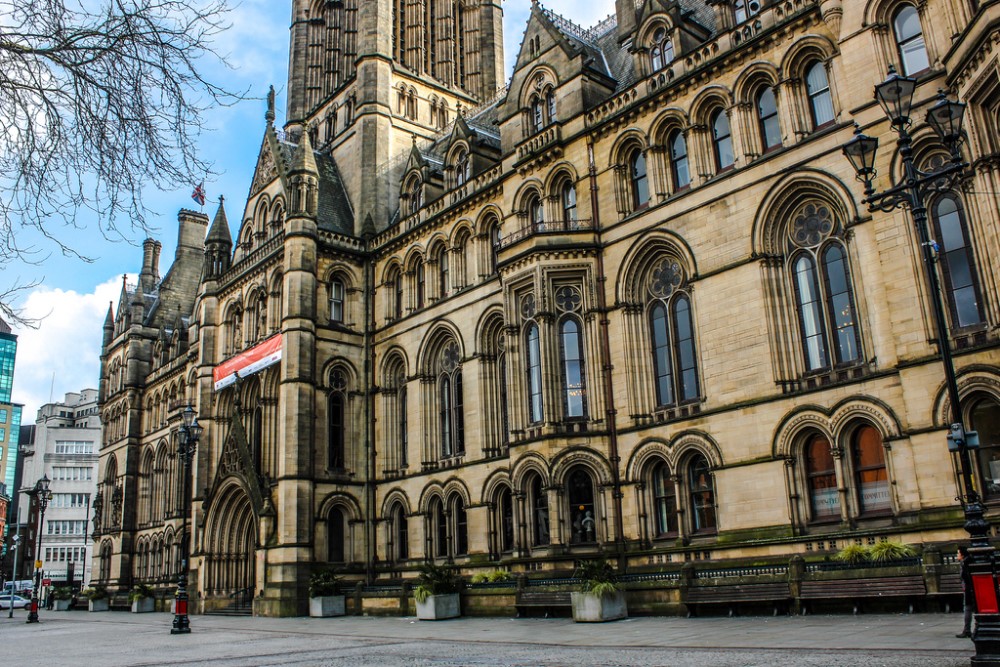
The Manchester Town Hall is a historical architectural jewel. Situated at Albert Square, it was constructed in the late 19th century in the Victorian Neo-Gothic style. The town hall’s striking design showcases intricate carvings, Gothic arches, and imposing structures, which greatly impress enthusiasts of architecture.
One remarkable characteristic is the clock tower, which stands at a height of over 280 feet and houses the Great Abel bell. Visitors can ascend the tower to enjoy panoramic views of the city.
Internally, visitors have the opportunity to explore the lavish interiors, which include the entrance hall, Great Hall, and Council Chamber. The building’s decorative stained glass windows and detailed ornamentation are truly awe-inspiring.
The town hall provides a variety of artifacts and exhibitions that depict the history of the city.
A useful tip for visitors is to participate in a guided tour in order to fully appreciate the architectural and historical importance of this iconic structure.
The John Rylands Library
The John Rylands Library is an impressive architectural treasure located in Manchester, UK. It was established in 1900 and designed by architect Basil Champneys. The library exhibits a stunning Neo-Gothic style, boasting intricate stone carvings, stained glass windows, and grand archways. The lofty ceilings and ornate details create a profoundly inspiring ambiance.
The John Rylands Library houses an extensive collection of rare books and manuscripts, making it a veritable trove for researchers and history enthusiasts. It comprises over 1.4 million printed books and more than 250,000 manuscripts, which includes the oldest known fragment of the New Testament.
Visitors can explore the breathtaking Reading Room, adorned with exquisite wooden bookshelves and exuding a serene atmosphere. The exhibition spaces present temporary displays that allow visitors to delve deeper into the library’s fascinating collections.
The library’s remarkable architecture and historical significance make it a popular destination for tourists and locals alike. Whether you have a passion for architecture, or simply an interest in history, a visit to the John Rylands Library promises to be an unforgettable experience.
The Beetham Tower
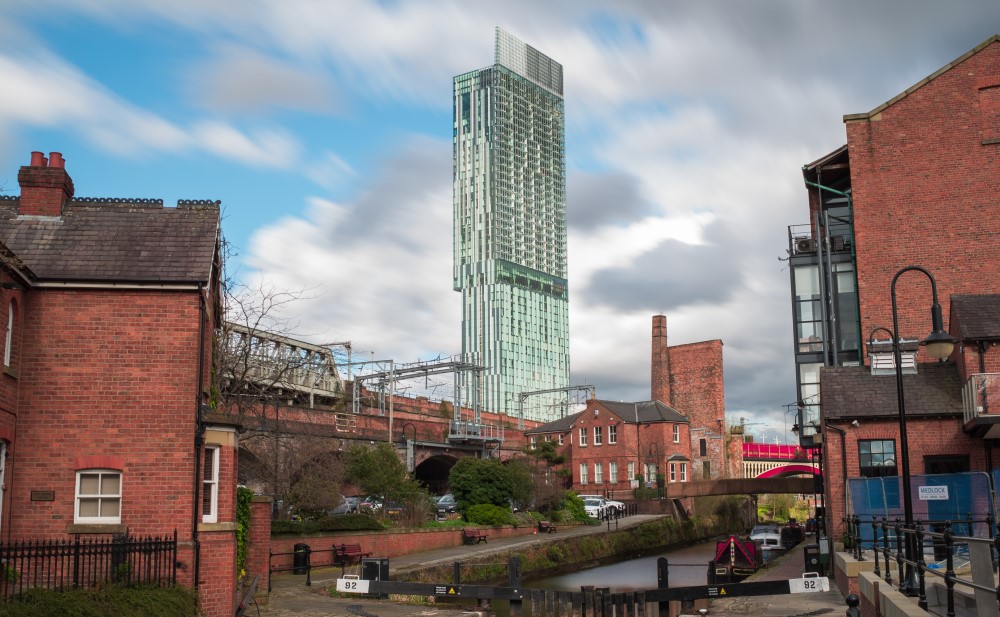
The Beetham Tower is a skyscraper in Manchester, UK. It stands at 554 feet tall, making it the tallest building in Manchester and one of the tallest residential buildings in Europe. The tower is renowned for its impressive design and contemporary architecture.
One notable feature of the Beetham Tower is the Hilton Hotel, which occupies the lower floors of the building. The hotel offers luxurious accommodations and panoramic views of the city. It provides amenities such as a fitness centre, spa, and stylish restaurants.
From the upper floors of the Beetham Tower, visitors can enjoy breathtaking views of the cityscape. On a clear day, the surrounding areas can be seen for miles. It is a great opportunity for photography enthusiasts.
For enthusiasts of architecture, the Beetham Tower offers insight into modern design and engineering. Its unique shape and glass facade are striking. The tower has received several awards for its innovative design.
To fully experience the Beetham Tower, consider taking a guided tour or visiting the observation deck. Here, you can learn about the tower’s construction, architectural significance, and its impact on Manchester’s skyline.
Whether you are visiting Manchester or appreciate architectural marvels, the Beetham Tower is a must-see attraction. Its grandeur and modern beauty make it stand out in the city’s skyline.
The Old Trafford Stadium
The Old Trafford Stadium in Manchester, UK is an iconic attraction. It is the home stadium of the football club, Manchester United. Constructed in 1910, it has a seating capacity of over 74,000, making it one of the largest football stadiums in the UK.
The stadium’s unique design and architecture have made it a landmark in the city. It has witnessed countless memorable matches and is often filled with passionate fans.
Visitors can enjoy guided tours of the Old Trafford Stadium, which take them behind the scenes and allow them to explore areas not accessible during matches. The tours include the iconic players’ tunnel and visiting the dressing rooms.
The stadium also houses the Manchester United Museum, where visitors can delve into the club’s history through interactive exhibits.
Whether you’re a football fan or appreciate impressive architecture, a visit to the Old Trafford Stadium is a must. It offers a unique experience that blends sports, history, and culture, making it a true gem in the city of Manchester.
Fun Fact: The Old Trafford Stadium is nicknamed “The Theatre of Dreams” by Manchester United fans, symbolising the dreams and aspirations of the club and its supporters.
The Imperial War Museum North
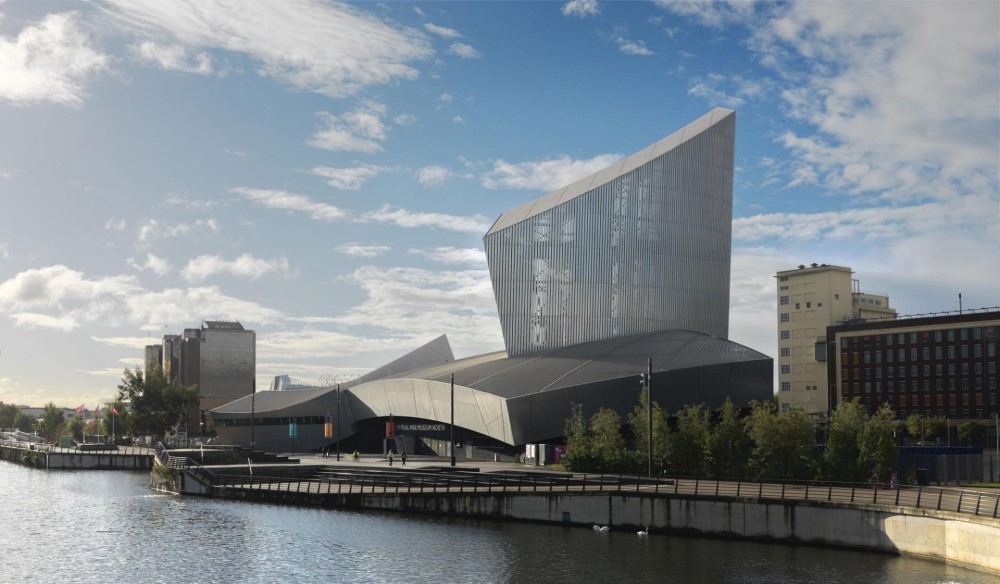
The Imperial War Museum North is an iconic architectural marvel in Manchester, UK. Designed by architect Daniel Libeskind, this museum symbolises the impact of war on people’s lives. Its unique shape reminds visitors of the destructive forces of war.
Inside, visitors can explore immersive exhibitions that chronicle conflict from the First World War to the present day. The museum offers a comprehensive view of the human experience during war, with personal stories and historical artefacts.
One highlight is the Big Picture Show, an audio-visual presentation showcasing the scale and impact of war through powerful images and narratives. Interactive displays allow visitors to engage with the content and gain a deeper understanding of historical events.
The Imperial War Museum North is a place of remembrance, learning, and reflection. It aims to foster a better understanding of war’s consequences and the importance of peace.
Fun Fact: The museum opened to the public in 2002 and has since welcomed millions of visitors from around the world, leaving a lasting impression on all who experience its exhibits.
The Manchester Cathedral
The Manchester Cathedral is a magnificent example of Gothic architecture. It boasts soaring spires and intricate stone carvings. The cathedral, which dates back to the 15th century, has played a significant role in the history of Manchester.
One notable feature of the Manchester Cathedral is its exquisite stained glass windows. These windows depict various biblical scenes and bring color and beauty to the interior.
Another highlight is the impressive organ of the cathedral, played by renowned musicians from around the world. The sound of the organ echoing through the majestic space is truly awe-inspiring. Visitors can attend organ recitals and experience the music in all its glory.
Guided tours are available for those interested in delving into the history of the cathedral, including its role during the English Civil War. These tours provide deeper insights into the building’s past.
In addition to being a place of worship, the Manchester Cathedral serves as a cultural hub. It hosts concerts, exhibitions, and community events, creating a lively and inclusive space for everyone.
During my visit to the Manchester Cathedral, I had the privilege of witnessing a choir performance. The acoustics of the cathedral were exceptional, and the voices of the choir filled the space with heavenly music. It was a magical experience that left me in awe of the beauty and grandeur of the cathedral.
The Bridgewater Hall

The Bridgewater Hall in Manchester is a must-visit for architecture enthusiasts. There are several reasons why:
1. Architectural Excellence: Designed by the renowned architect Sir Norman Foster, The Bridgewater Hall showcases modern architecture with a unique blend of glass, steel, and brick.
2. Acoustic Superiority: The hall is highly regarded for its exceptional acoustics and has hosted performances of the highest calibre. It is the home of the Hallé Orchestra and showcases state-of-the-art sound engineering.
3. Magnificent Auditorium: With a seating capacity of over 2,400 and tiered seating, every seat in the venue offers a fantastic view of the stage, providing an immersive experience for the audience.
4. Extraordinary Organ: The hall is proud to house the Marcussen Organ, one of Europe’s finest organs, boasting an impressive 5,500 pipes and mesmerising sound quality.
Pro-tip: Take a look at The Bridgewater Hall’s event schedule if you have a passion for music. Witness the architectural brilliance and acoustic excellence for an unforgettable cultural experience.
The People’s History Museum
The People’s History Museum in Manchester, UK, explores the history and struggles of the working class. It offers an immersive experience that helps visitors understand the challenges that shaped ordinary people’s lives.
The museum showcases a wide range of exhibits, including archival material, artefacts, and interactive displays. These illustrate the impact of the working class on society. The collection includes over 100,000 items, providing a comprehensive view of the UK’s working class movement.
Visiting the People’s History Museum allows you to learn about significant events like the Peterloo Massacre and the Suffragette movement. Exploring these exhibits helps you appreciate the struggles and achievements of the working class throughout history.
The museum also offers educational programmes and events for students, history enthusiasts, and anyone curious about the past.
The Museum of Science and Industry
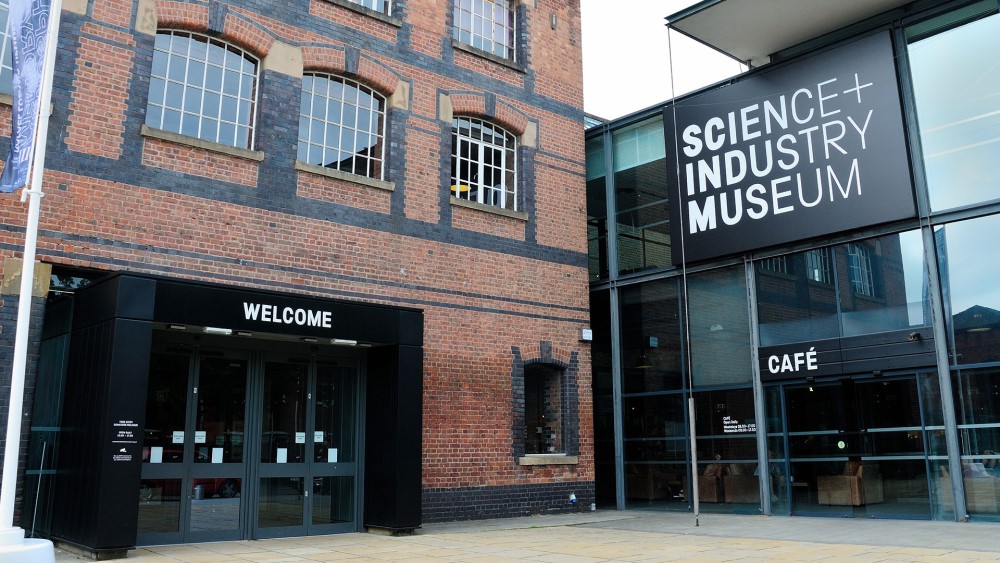
The Museum of Science and Industry in Manchester is a captivating attraction for those who love architecture. It showcases the impact of the industrial revolution on the city’s development. The building itself is an outstanding example of Victorian architecture.
Originally constructed as a railway station in 1830, it is the oldest surviving railway station for passengers in the world.
Inside, visitors have the opportunity to explore exhibits that highlight Manchester’s history and technological advancements. The museum covers the cotton industry and the evolution of modern machinery, providing a comprehensive understanding of the city’s industrial past.
The Power Hall is a remarkable feature of the museum, housing an extensive collection of functional steam engines. These impressive machines offer a glimpse into the force that propelled the industrial revolution.
Interactive displays in the museum allow visitors to engage with scientific principles and conduct experiments. There are also hands-on workshops and interactive exhibits that provide ample opportunities for learning and exploration.
The museum offers guided tours and lectures on subjects related to science, technology, and industry. These educational opportunities provide further insight into the museum’s collections.
For architecture enthusiasts, the Museum of Science and Industry is a must-visit destination in Manchester. It not only provides a glimpse into the city’s industrial past but also showcases the beauty and ingenuity of Victorian architecture.
The Lowry
The Lowry, an art gallery and theatre, is located in Salford Quays.
Completed in 2000, it has become a popular attraction for art and architecture enthusiasts.
The Lowry displays a variety of visual arts, including paintings, sculptures, and photography.
In addition to the art gallery, The Lowry also includes two main theatres: the Lyric Theatre and the Quays Theatre.
These venues offer a wide range of performances, including plays, musicals, dance shows, and comedy acts.
The architecture of The Lowry is contemporary and distinctive, with a striking glass and steel exterior.
It pays tribute to the industrial heritage of the area, honoring the former docks at Salford Quays.
Inside, The Lowry showcases spacious galleries and state-of-the-art theatre facilities.
Visitors to The Lowry can not only appreciate the incredible art and performances, but also enjoy the picturesque views of Salford Quays.
The location offers a vibrant atmosphere, with waterfront restaurants, bars, and shops.
Fact: The Lowry gets its name from the renowned British artist L.S. Lowry, whose distinctive paintings depicting industrial landscapes and everyday life in northern England are prominently displayed in the art gallery.
The National Football Museum
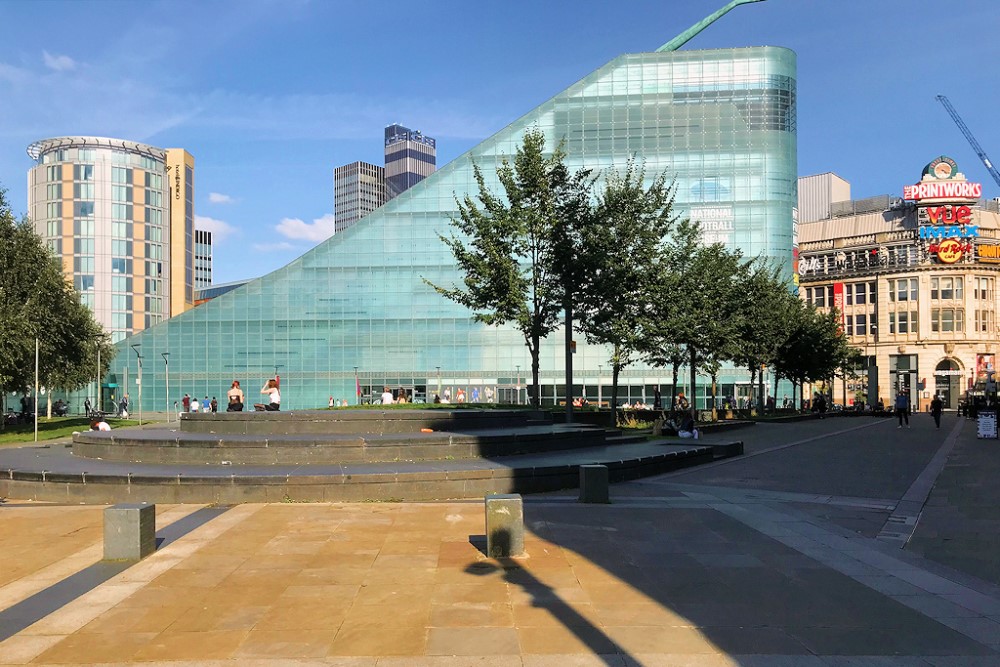
The National Football Museum in Manchester is a must-visit for football enthusiasts. This museum offers insight into the history and culture of the game.
1. Interactive Exhibits: The museum has interactive exhibits that engage visitors of all ages. You can test your skills in the Skills Zone or experience penalty shootouts.
2. Football Memorabilia: From iconic football shirts to historical artefacts, the National Football Museum houses an extensive collection of memorabilia. You can see trophies, boots, and jerseys worn by legendary players.
3. Exhibitions: The museum hosts temporary exhibitions that showcase different aspects of the sport, such as the evolution of football tactics or the impact of football on society. These exhibitions enrich your understanding of the game.
4. Hall of Fame: The National Football Museum pays tribute to football’s greatest players, managers, and teams in its Hall of Fame. Here, visitors can learn about the achievements and contributions of football icons.
5. Educational Opportunities: The museum offers educational programmes and workshops for schools and other groups. These programmes provide a unique opportunity to cultivate a deeper understanding of football’s history and cultural significance.
Whether you are a football fan or simply curious about the sport, the National Football Museum promises an immersive and educational experience. It celebrates the rich legacy of football, making it a must-visit attraction for all.
The Manchester Art Gallery
The Manchester Art Gallery is a destination that must be visited by art enthusiasts. This renowned gallery exhibits a wide-ranging collection of artworks from different periods and genres. It supports both local and international artists, fostering a vibrant artistic community.
The gallery’s impressive architecture enhances the overall experience. Inside, you will discover a variety of art pieces, including paintings, sculptures, ceramics, and textiles. The gallery’s collection of Pre-Raphaelite paintings is a significant highlight for many visitors.
Art lovers can explore the extensive displays of the gallery, which encompass over six centuries of art history. From classical masterpieces to contemporary works, there is something to captivate the interest of all individuals. The Manchester Art Gallery regularly organises exhibitions that showcase new artistic trends and local talents.
A visit to the Manchester Art Gallery unlocks doors to creativity and inspiration. Whether you desire to augment your knowledge of art or simply admire its beauty, a visit to this gallery will make a lasting impression. Please remember to include the Manchester Art Gallery in your itinerary when exploring Manchester.





